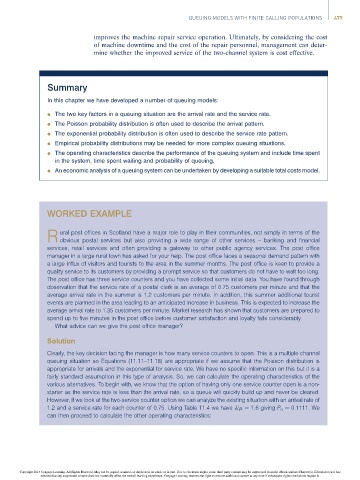Page 499 -
P. 499
QUEUING MODELS WITH FINITE CALLING POPULATIONS 479
improves the machine repair service operation. Ultimately, by considering the cost
of machine downtime and the cost of the repair personnel, management can deter-
mine whether the improved service of the two-channel system is cost effective.
Summary
In this chapter we have developed a number of queuing models:
l The two key factors in a queuing situation are the arrival rate and the service rate.
l The Poisson probability distribution is often used to describe the arrival pattern.
l The exponential probability distribution is often used to describe the service rate pattern.
l Empirical probability distributions may be needed for more complex queuing situations.
l The operating characteristics describe the performance of the queuing system and include time spent
in the system, time spent waiting and probability of queuing.
l An economic analysis of a queuing system can be undertaken by developing a suitable total costs model.
WORKED EXAMPLE
ural post offices in Scotland have a major role to play in their communities, not simply in terms of the
R obvious postal services but also providing a wide range of other services – banking and financial
services, retail services and often providing a gateway to other public agency services. The post office
manager in a large rural town has asked for your help. The post office faces a seasonal demand pattern with
a large influx of visitors and tourists to the area in the summer months. The post office is keen to provide a
quality service to its customers by providing a prompt service so that customers do not have to wait too long.
The post office has three service counters and you have collected some initial data. You have found through
observation that the service rate of a postal clerk is an average of 0.75 customers per minute and that the
average arrival rate in the summer is 1.2 customers per minute. In addition, this summer additional tourist
events are planned in the area leading to an anticipated increase in business. This is expected to increase the
average arrival rate to 1.35 customers per minute. Market research has shown that customers are prepared to
spend up to five minutes in the post office before customer satisfaction and loyalty falls considerably.
What advice can we give the post office manager?
Solution
Clearly, the key decision facing the manager is how many service counters to open. This is a multiple channel
queuing situation so Equations (11.11–11.18) are appropriate if we assume that the Poisson distribution is
appropriate for arrivals and the exponential for service rate. We have no specific information on this but it is a
fairly standard assumption in this type of analysis. So, we can calculate the operating characteristics of the
various alternatives. To begin with, we know that the option of having only one service counter open is a non-
starter as the service rate is less than the arrival rate, so a queue will quickly build up and never be cleared.
However, if we look at the two-service counter option we can analyze the existing situation with an arrival rate of
1.2 and a service rate for each counter of 0.75. Using Table 11.4 we have l/ ¼ 1.6 giving P o ¼ 0.1111. We
can then proceed to calculate the other operating characteristics:
Copyright 2014 Cengage Learning. All Rights Reserved. May not be copied, scanned, or duplicated, in whole or in part. Due to electronic rights, some third party content may be suppressed from the eBook and/or eChapter(s). Editorial review has
deemed that any suppressed content does not materially affect the overall learning experience. Cengage Learning reserves the right to remove additional content at any time if subsequent rights restrictions require it.

